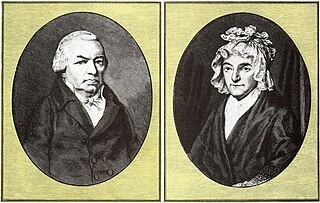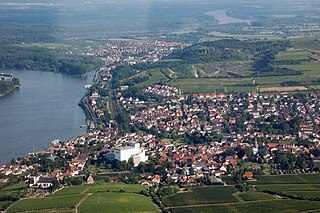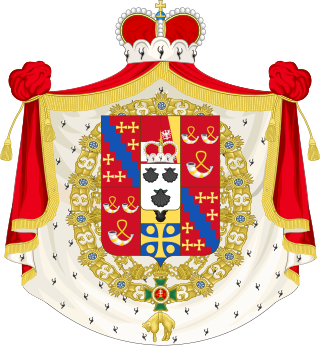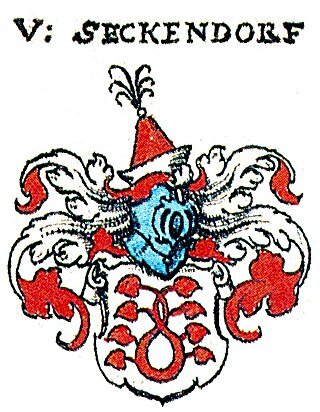
Trippstadt House (German : Trippstadter Schloss) is an 18th-century, baroque schloss or manor house in the eponymous village in the German state of Rhineland-Palatinate.

Trippstadt House (German : Trippstadter Schloss) is an 18th-century, baroque schloss or manor house in the eponymous village in the German state of Rhineland-Palatinate.
The building is made of red sandstone and comprises a single wing and is 48 metres long by 19 metres wide and 18 metres high. It has one basement and two storeys. Above the entrance is a relief of the coat of arms of the Hacke and Sturmfeder alliance.
The gable above the front entrance shows a relief, the date 1766 and the names or the arms of alliance of its first owners, Franz Karl Joseph von Hacke (son of Ludwig Anton von Hacke) and Amöna Marie Charlotte Juliane Sturmfeder von Oppenweiler, who was a daughter of local Dirmstein nobleman, Marsilius Franz Sturmfeder von Oppenweiler.
In 1767, an underground water supply was built at the Quellbachhübel, [1] northeast of the residential buildings. It consisted of a spring chamber, in which the water from various springs collected, and three accessible galleries into which the water was directed downwards at a slight gradient to the castle well or to two other wells in the residential area. The latter two, the "Upper Well" and the "Deer Well", were destroyed after 1965, [1] the tunnel to the castle well, which has been preserved over a length of 300 m, is now called the "Well Tunnel" and is one of the cultural monuments of the municipality.
The house was built in 1767 by the architect, Sigmund Jacob Haeckher, and called Maison de la Campagne ("Country House"). Its owner was Franz Karl Freiherr von Hacke and his wife, Amönia Freiin von Sturmfeder. He was the master hunter (Obristjägermeister) of Electoral Palatine, responsible for hunting in the 55 km2 Barony of Wilenstein. The first lightning conductor in the Palatinate was installed at the house on 17 April 1776 by physicist, Johann Jakob Hemmer, from Mannheim. [2] Its French garden was planned and executed around 1780 by landscape architect, Friedrich Ludwig von Sckell, [3] who was also responsible for its natural extension, the attractive valley of Karlstal through which the Moosalb stream flows.
French Revolutionary troops partly destroyed the house on 13 July 1794, leaving only the cellars inhabitable. The house went into Alsatian possession in 1803. The entire manorial estate of Trippstadt, including the house, was sold in 1833 by Reichsrat, [4] Ludwig von Gienanth. [3]
In 1865, the Freiherr von Gienanth sold the house to the Kingdom of Bavaria. They established a state forestry office there in 1885 and, in 1888, rebuilt the ruined part of the house. A forestry school was opened in the house. In 1915, during the First World War, the school had to be closed. Not until 1946, after the Second World War, was it re-opened as a school of forestry for the Palatinate. [3]
The house was home to the Rhineland-Palatinate State School of Forestry from 1960 to 1980. In 1985, the municipality of Trippstadt took over the management of the gardens and turned them into a recreation area. In 1987, the house became the home of the Forest Research Institute of the state of Rhineland-Palatinate. [3]

Johann van Beethoven was a German musician, teacher, and singer who sang in the chapel of the Archbishop of Cologne, whose court was at Bonn. He is best known as the father of the celebrated composer Ludwig van Beethoven (1770–1827). Johann became an alcoholic later in his life and was at times an abusive father to Ludwig. At 18, Ludwig had to obtain an order to force Johann to support his family. Johann died soon after Ludwig moved to Vienna to study with Joseph Haydn.

The Diocese of Basel is a Latin Catholic diocese in Switzerland.

The House of Leiningen is the name of an old German noble family whose lands lay principally in Alsace, Lorraine, Saarland, Rhineland, and the Palatinate. Various branches of this family developed over the centuries and ruled counties with Imperial immediacy.

Nassau is a town located in the German state of Rhineland-Palatinate. It lies on the lower course of the Lahn River, on the mouth of the Mühlbach, between Limburg an der Lahn and the spa town of Bad Ems, and is located in the Nassau Nature Park, surrounded by the Westerwald to the north and the Taunus to the south. The town is on the German-Dutch holiday road, the Orange Route. As of 2021, it had a population of 4,592.

Nierstein is a town belonging to the Verbandsgemeinde Rhein-Selz in the Mainz-Bingen district in Rhineland-Palatinate, Germany.

Bad Bergzabern is a municipality in the Südliche Weinstraße district, on the German Wine Route in Rhineland-Palatinate, Germany. It is situated near the border with France, on the south-eastern edge of the Palatinate forest, approximately 15 kilometres (9.3 mi) southwest of Landau.

Hohe Karlsschule was the strict military academy founded by Karl Eugen, Duke of Württemberg in Stuttgart, Germany. It was first founded in 1770 as a military orphanage, but then converted into a military academy in 1773 for the duke.

Karl Theodor Maria Georg Achaz Eberhardt Josef Freiherr von und zu Guttenberg was a German politician of the Christian Social Union of Bavaria (CSU). He was parliamentary secretary of state in the Chancellor's Office in the government of Kurt Georg Kiesinger from 1967 until 1969, as well as the foreign policy spokesman of the CDU/CSU group in the Bundestag. Guttenberg was perceived as a conservative anticommunist as well as a proponent of European integration. His work was mostly within the field of foreign policy.

Raitz von Frentz is the name of a baronial (freiherrlichen) family, that belongs to the German ancient nobility (Uradel). The Barons Raitz von Frentz should be distinguished from the dynastic family "von Frenz", a branch of the Dukes of Limburg, that became extinct in the 14th century.

The House of Metternich was an old German noble family originating in the Rhineland. The most prominent member was Prince Klemens von Metternich, who was the dominant figure at the Congress of Vienna (1814–1815). As a former reigning house (mediatised), the Metternich family belonged to the small circle of high nobility.

The Moosalb is a stream in West Palatinate in the German state of Rhineland-Palatinate. The upper Moosalb valley is also called the Hammertal on account of the many witnesses, in the form of ruined buildings and structures, to the iron smelting and working industries of the 18th and 19th centuries.

The House of Sustainability is a project run by the Rhineland-Palatinate Ministry for the Environment and Consumer Protection. The house is in the hamlet of Johanniskreuz in the German municipality of Trippstadt in the middle of the Palatinate Forest within the Palatine Forest-North Vosges Biosphere Reserve. The purpose of the house is to illustrate the concept of sustainability, especially to its adult visitors. The House of Sustainability is part of the Rhineland-Palatinate Efficiency Network or EffNet, which aims to deliver better resource efficiency.

The Amseldell is a former park-like leisure area about two kilometres west of the German town of Trippstadt in the Palatine Forest in the state of Rhineland-Palatinate.

The House of Seckendorff is the name of an old and prolific Franconian noble family. According to historian Werner Wagenhöfer, the Seckendorff family is the most researched family of the low nobility in Franconia along with the Guttenberg and Bibra families.

Carl Philipp von Venningen was an imperial knight from the family of the Lords of Venningen. He was chief minister of Electoral Palatinate. As a child, he was the last living male descendant of the von Venningen family and so he inherited the whole family estate at Kraichgau, where he left his mark at Eichtersheim and elsewhere through an extensive building programme.